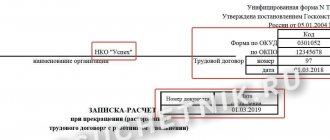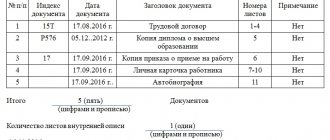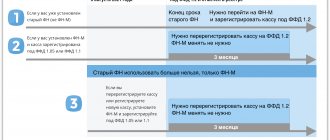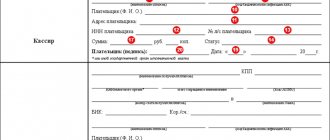According to the “Basic Rules for the Operation of Archives of Organizations”, approved. By the Board of Rosarkhiv dated 02/06/2002, all files of permanent or temporary storage (more than 10 pages) are subject to full registration. This means that the case needs to be hemmed or bound, and also numbered. Then you need to prepare a certification sheet and, if necessary, an internal inventory of the attached documents. The same norm is stipulated in the Rules of Archival Affairs, approved. Ministry of Culture (Order No. 526 of January 31, 2015). For your information, it is these two normative acts that should be relied upon when preparing cases for their subsequent transfer for archiving.
It follows that the preparation of a certification sheet is a mandatory requirement for the complete registration of the case, which is transferred for archival preservation of at least 10 pages. This is an important document that contains mandatory information about the number of numbered sheets of the case, internal inventory, and other nuances of numbering.
The compilation and preparation of the certification sheet is carried out for the most part using the norms and regulations determined by the Rules, approved. By Order of the Ministry of Culture of the Russian Federation No. 526 of March 31, 2015.
Format, form of certification sheet
So, before transferring the case for preservation, it must be formalized in the generally established manner. To do this, you will need, among other things, to fill out a certification sheet, indicating the number of sheets of the case, their actual physical condition and the nuances of numbering. It should be noted that we are talking about cases that are executed on paper.
A standard one-page form is provided for the certification sheet. One of its later versions is presented in Appendix No. 9 of the Rules, approved. Rosarkhiv, and the second – Appendix No. 8 of the Rules, approved. Ministry of Culture of the Russian Federation. Both options are almost identical and require entering the same data.
Unlike the first, the second form, introduced by order of the Ministry of Culture of the Russian Federation (Appendix No. 8), is supplemented with one more line. It needs to detail the filed and numbered sheets, i.e. indicate the numbers of the first and last sheet. Otherwise, both the form and the procedure for filling out the form for 2022 have not undergone any changes and remain the same.
| Form of certification sheet | Who approved the form, where can it be found? |
| Adj. No. 8 to Order of the Ministry of Culture of the Russian Federation No. 526 of January 31, 2015 | |
| Adj. No. 9 to the Rules, approved. By decision of the Board of Rosarkhiv dated 02/06/2002 |
It is believed that the Rules, which are approved by the Federal Archive, are more of a methodological nature, and the Rules, approved. Order No. 526 of the Ministry of Culture of the Russian Federation is normative. For practical purposes, the latter document has dominant meaning. Accordingly, the form of the certification sheet introduced by a more current order of the Ministry of Culture will be considered below.
Contents of the certification sheet drawn up for the case: what should be filled out
To prepare the certification sheet, it is recommended to use a separate sheet of paper in A 4 format (210 x 297 mm), which can be hemmed after filling.
Its standard form includes standard document details, as well as information related to the case filed for archival storage. The structure of the form provides for entering the following information:
- No., title, date of compilation;
- position held, handwritten signature of the compiler with subsequent transcript;
- total number of case sheets;
- lettered and missing sheet numbers, if available;
- number of internal inventory sheets;
- information about the actual physical state of the case, indicating the number of sheets.
The completed case must have a template composition, noted above by the above-mentioned regulations. In particular, the cover, title, internal inventory, attached, filed documents, certification sheet.
As established, such cases should include no more than 250 pages with a thickness of up to 4 cm. A copy of each document for one specific year is attached to them. An exception may be judicial, transitional or personal cases that are conducted throughout the entire period of the employee’s working life.
Applications, if available, are attached to the documents. If one application includes more than 250 sheets, it is prepared in a separate volume, about which a corresponding note is made in the document.
What personal files should an inventory be compiled for?
The law does not require an internal inventory of documents stored in the personal files of employees. However, there are some cases to which an inventory must be attached (as reflected in the relevant legislative regulations). These include
- those folders that are transferred to the enterprise archive for permanent or long-term storage (over 10 years),
- as well as those that have a simple heading “personal file” (that is, it is not clear from them exactly what documents and in what quantity they contain).
How to properly prepare a certification sheet
When registering, you should take into account the norms of clause 3.6.16 of the Rules, approved. Rosarkhiv. They, as well as the procedure introduced by the Ministry of Culture, established that the certification sheet should be drawn up on a separate sheet if we are talking about a file or file cabinet. If it is drawn up for a book, then it is drawn up on the back of the last blank sheet of the book. When filling out the form, it is recommended to take into account the following explanations:
- The document number is determined according to the nomenclature of cases.
- The number of pages of the case is written down on the certification sheet, first in numbers and then in words. The internal inventory is not taken into account.
- Letter numbers are numbers with a letter that are used when one or a number of pages are omitted (for example, 1a, 19b). To avoid renumbering anything, the omitted pages are assigned numbers with letters.
- In the absence of data, when there are, for example, omitted or lettered pages, dashes are placed in the empty lines.
- The number of sheets of the internal inventory is also written down sequentially, first in numbers and then in words.
- By the features of the physical state of the case, which must be indicated in the table, we mean the distinctive specific features characteristic of it. They can be: damaged, hard-to-read pages, the presence of pasted-on photos, envelopes with contents, large-scale sheets, etc. If these are absent, the table is crossed out with the letter Z.
- The position of the responsible compiler and his handwritten signature with a transcript are indicated in the usual manner.
Often, after the case has been processed and submitted for preservation, changes are made to its composition. This happens for various reasons: when documents are damaged or when it is necessary to replace the original document with a photocopy.
Whatever changes are made to the composition of the case, they always need to be recorded. This is usually done with the help of an act where they are noted. Next, a corresponding note is made on the certification sheet with a reference to this act, certified by the signature of the responsible authorized archive employee.
Are changes (corrections) made to the record sheet?
Various situations arise during the storage of documents or during the life of the company.
For example, you needed some document from a filed file. In this case, you can take the original from the file, but leave a copy there.
Or, God forbid, there is a fire or flood in the place where the documents are stored and they will be irretrievably damaged.
And the most obvious example would be this. The work record book of the resigned employee lay in the organization for a long time, then it was sent to the archives. And, suddenly, unexpectedly, they come for work. You have to take it out of the envelope in the case and give it back.
To record all these changes, an act of fact of change is drawn up, corrections and notes are made on the record sheet.
It also happens that in a budgetary institution, during an inspection by a higher authority, it becomes necessary to add a sheet to the filed file. In this case, you need to assign a letter number to the new sheet, expand the file and add a sheet to it. Accordingly, corrections are made to the witness sheet and the internal inventory is changed.
Example 1. Sample of filling out the form of the certification sheet
The sample certification sheet in question was compiled by clerk B.L. Raznichenko. The form contains the following information:
- Certification sheet number (“15/2022”).
- The total number of filed and numbered sheets (indicated in numbers “50” and in words “fifty”), as well as:
- present letter numbers of sheets (“11a” and “14a”);
- No. of sheets that are missing (“35” and “40”);
- internal inventory sheets (indicated in numbers “2” and in words “two”);
- Folded plan diagram in A3 format, 5 pages.
The certification sheet is dated 08/09/2022 and signed personally by the clerk B. L. Raznichenko. The data used in the proposed sample is conditional. A form has been taken to fill out, approved. Order of the Ministry of Culture of the Russian Federation No. 526 (see form No. 1 presented in the table above). The information included in it is highlighted in yellow.
Other requirements for registration of cases transferred for archival storage
Turning again to the methodological basis of the Rosarkhiv Rules, special attention should be paid to some features of the complete registration of permanent (temporary) storage files. This point is important especially in terms of systematization, processing, and grouping of documentation. It is self-evident that the correct approach to this stage of the procedure and compliance with the general requirements for registration simplifies the entire process of preparing cases for their subsequent transfer for storage.
As a standard, documents attached to the case are simply bound or filed in a hard cardboard cover (for 4 protocols). In this case, all pins and other metal fasteners are removed. Unclaimed labor, military IDs, etc. documents are placed in an envelope, and it is filed with the file. If there are many such unclaimed documents, then they are drawn up as an inventory autonomously. Next, in order of priority, at the end of the case being drawn up, a blank certifying sheet is filed, and at the beginning - an internal inventory form, which is also used to record valuable documentation.
Particular attention should be paid to the peculiarities of the numbering of attached documents, which are described in detail in clause 3.6 of the Rules, approved. Rosarkhiv. This point is really important, since the correct arrangement of pages determines the accurate, adequate and complete execution of the entire file, including the certification sheet.
So, according to the requirements of the Federal Archive, all sheets are subject to gross numbering, which is typical, in Arabic numerals. But it does not affect the witness’s form, and the inventory is numbered separately, in a separate order. Volumes and parts are also numbered separately, and on illustrative materials (photos, diagrams, etc.) page numbers are placed at the top, on the reverse side of the sheet.
Each folded sheet (in relation to A3 and A2 formats) is numbered in unfolded form in the upper margin on the right. The sheet on which photos, clippings and other documentation are closely glued should be numbered as one sheet. If documents are glued to the sheet with one edge, then everything must be numbered separately.
And one more nuance that should be taken into account. Envelopes with contents are also numbered separately: first the envelope itself, and then, in turn, all the attachments. Periodicals are often included in the case. As a rule, such documents, especially printed publications, have their own numbering. If it “fits” into the arrangement of sheets, then it is allowed to be saved. If not, then in this publication (another document) numbers are given in the general order.
Frequently encountered errors and questions on the topic
Mistake #1.
When compiling cases, there can be many nuances in the numbering of sheets, so if the case has many difficulties in compiling, then it is best to first “sketch out” a draft, and then draw up a sheet - the witness in its final form.
Mistake #2.
It is necessary to file documents in the case. Among the documents that do not raise doubts regarding the assignment of sheet numbers, there are brochures with the last blank sheet. There are also sheets of non-standard format, but only partially filled. Since the cover cannot be torn off from the brochure, and the sheets may not be filled over the entire area, each sheet is numbered in order, without gaps.
Common mistakes when preparing a certification sheet
Error 1. You cannot place a properly executed certification sheet on the front main side of the cover of the bound case. It is also prohibited to attach it to the last document in the file, even to its reverse part, which has nothing on it.
In practice, two methods of placing a certification sheet are used, which are recognized as correct. First: it is drawn up separately, on a separate sheet and filed at the end of the case. Second: in finished form, glue the upper part of the certification sheet to the back side of the top cover. The last option is used when the case has been filed or bound without a certification sheet.
Error 2. A certification sheet for temporary storage matters is not required. As a rule, such cases are not numbered or stitched together. They are usually filed in folders and left in this form for temporary storage in the organization. After expiration of the storage period, they are destroyed.
Important! Temporary storage of a file means a period of storage of up to 10 years.
WE PREPARE DOCUMENTS FOR REGISTRATION
- We remove unnecessary things. Most likely, until now the documents were kept in filing folders. It is too early to remove documents from them. To begin, let's look through each folder and remove from it drafts, doublet (repeated) copies of documents, sheets of notes, and from the documents themselves - paper clips and staplers.
- We divide things into volumes. At this stage, we determine how many volumes of the case will end up and how best to divide the documents into volumes: by month, by number of sheets, by counterparties, by last names, etc. In accordance with clause 4.20 of the Rules for organizing the storage, acquisition, recording and use of documents of the Archival Fund of the Russian Federation and other documents in government bodies, local governments and organizations (approved by order of the Ministry of Culture of Russia dated March 31, 2015 No. 526; hereinafter referred to as the 2015 Rules) Each case should contain no more than 250 sheets.
It is not at all necessary to come up with some kind of system for dividing documents into volumes; it is enough to follow this rule. The uniform distribution of sheets, firstly, allows you to create volumes that are approximately equal in thickness, and secondly, it makes it easier to find documents in your file. Thus, if the file contains approximately 300 sheets, then it is better to make two volumes of 150 sheets each, rather than 250 and 50.
Then we carefully remove the documents from the folders, distribute them into volumes and begin processing them for storage.
Answers to frequently asked questions
Question No. 1: What to do if, when preparing a case for submission for storage, many errors are found in the numbering of sheets?
Clause 3.6.15 of the Rosarkhiv Rules states that in such situations they are renumbered. How does this happen? The previous (old) numbers are simply crossed out and new ones are written in their place. What is important is that when renumbering, another certification sheet is drawn up, but the old one is not withdrawn - it is simply crossed out and left on file.
If there are not many errors, then, according to the Rules, when preparing a file for submission to the state archives, it is allowed to use lettered sheet numbers. But such use must be previously agreed upon with the state archive itself.
Question No. 2: How to correctly calculate the total number of stitched, numbered sheets of the case?
When counting, you should add the letters and take into account the missing sheets. So, for example, there are only 100 sheets in the file. In addition to them, there is one omitted sheet (“51”) and two lettered ones (21a and 21b). The calculation is made as follows: 100 + 2 – 1 = 101. In total, the total number of sheets in the file is 101.
Leaf - witness: what is it and what is it “eaten with”
In the course of their activities, every accountant is faced with the fact that at the end of a certain period of time, the entire volume of documents existing in the enterprise must be sorted and filed. This is where elements of office work appear in the work of a specialist. All documents for a particular accounting area are stitched into a file. This allows you to maintain order in documents and monitor their safety in the enterprise.
The certification sheet is drawn up and filled out on the basis of the Archival Rules adopted in 2015 (Appendix No. 8).
The witness sheet allows you to take into account all the features when drawing up the case. With its help, all non-standard moments are fixed when numbering sheets in the case, the nuances of compiling the case itself are indicated .
The certifier sheet must be present in file files for documents whose storage period is more than 10 years.






